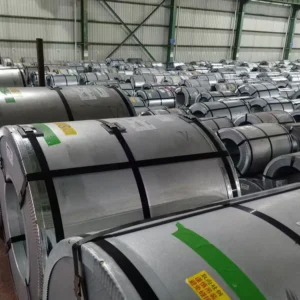The development and production of electrical steel involve advanced metallurgical processes designed to enhance its magnetic properties. As global energy needs grow, the efficiency and reliability of electrical steel become more critical. This article will provide a comprehensive overview of electrical steel, its different types, its myriad benefits, and the various challenges faced by the industry in adapting to technological advancements and fluctuating market demands.
What is Electrical Steel?
Electrical steel, also known as silicon steel, is a type of steel that contains silicon as its key alloying element. This silicon content enhances the steel’s electrical properties, making it highly efficient for use in electrical applications. The primary function of electrical steel is to reduce energy losses due to its magnetic properties, which is critical in minimizing power loss in transformers and other electrical devices. The addition of silicon increases the electrical resistivity of the steel, thereby decreasing the eddy current losses.
Moreover, electrical steel is characterized by its ability to maintain its magnetic properties over a wide range of temperatures and frequencies. This makes it indispensable in applications that require consistent performance under varying operational conditions. The steel’s microstructure can be manipulated during production to tailor its properties for specific applications, allowing for the creation of specialized grades of electrical steel to meet diverse industry needs.
Types of Electrical Steel
There are two main types of electrical steel: CRGO and CRNGO. Understanding the differences between these two is essential for choosing the right material for various applications. Each type has unique characteristics that make it suitable for specific uses, influencing the efficiency and performance of the devices in which they are used.
CRGO: Cold Rolled Grain Oriented Steel
CRGO, or Cold Rolled Grain Oriented steel, is engineered specifically for applications requiring high magnetic permeability. The grains in CRGO are aligned in a particular direction, which enhances its magnetic properties and reduces energy loss. This alignment is achieved through a meticulous cold rolling process that orients the grains in the steel, optimizing it for use in devices where directional magnetic properties are critical.
Key Features of CRGO
- High magnetic permeability: This allows for efficient magnetic flux, reducing the amount of energy wasted. The alignment of grains in CRGO steel significantly enhances its ability to channel magnetic fields, making it ideal for high-performance applications.
- Low core loss: The alignment of grains results in minimal energy dissipation, making CRGO highly efficient. This efficiency translates to reduced operational costs and enhanced durability of electrical devices.
- Applications: CRGO is primarily used in the cores of transformers and other high-efficiency electrical devices. Its superior magnetic properties make it the preferred choice for large transformers and electrical grids, where minimizing energy loss is paramount.
CRNGO: Cold Rolled Non-Grain Oriented Steel
CRNGO, or Cold Rolled Non-Grain Oriented steel, has a random grain structure, making it more versatile and suitable for different applications. Unlike CRGO, the grains in CRNGO steel are not aligned in a specific direction, which provides uniform magnetic properties regardless of the orientation of the steel.
Key Features of CRNGO
- Uniform magnetic properties: The random grain orientation provides consistent magnetic properties in all directions. This uniformity is particularly beneficial in applications where the direction of the magnetic field is variable.
- Cost-effective: Generally more affordable than CRGO, CRNGO is often used in applications where cost is a critical factor. Its versatility and lower production cost make it accessible for a broader range of applications.
- Applications: CRNGO is commonly used in electric motors, generators, and other rotating machines. Its adaptability makes it suitable for various devices, particularly those that require reliable performance across different operational scenarios.
Benefits of Using Electrical Steel
The use of electrical steel provides numerous benefits, particularly in the energy sector. Here are some of the key advantages that highlight why electrical steel remains an indispensable material for modern electrical systems:
Energy Efficiency
One of the primary benefits of electrical steel is its ability to minimize energy loss. By reducing core losses, electrical steel improves the overall efficiency of transformers and motors, leading to significant energy savings. This improved efficiency not only lowers operational costs but also enhances the longevity of the equipment by reducing heat generation and wear.
Enhanced Performance
Electrical steel’s unique properties contribute to better performance in electrical devices. High magnetic permeability and low energy loss mean transformers and motors can operate more efficiently and with less heat generation. This results in increased reliability and reduced maintenance requirements, making electrical steel a cost-effective choice over the long term.
Environmental Impact
By increasing energy efficiency, electrical steel helps reduce the overall carbon footprint of electrical systems. Lower energy consumption leads to decreased emissions, supporting global efforts to combat climate change. The use of electrical steel contributes to the development of sustainable energy solutions, aligning with international goals for reducing greenhouse gas emissions and promoting cleaner energy sources.
Applications of Electrical Steel
Electrical steel is vital in various industries, particularly in energy production and distribution. Its application extends beyond just power generation, playing a crucial role in the efficient functioning of numerous electrical devices and systems. Here are some of the key applications:
Transformers
Transformers are critical components in the power grid, and electrical steel is essential for their operation. CRGO steel is typically used in transformer cores due to its high efficiency, which minimizes energy loss and heat generation. This efficiency is critical for maintaining the reliability of power grids and ensuring the steady supply of electricity to consumers.
Electric Motors
Electric motors rely on CRNGO steel for its uniform magnetic properties. This makes CRNGO ideal for motors that require consistent performance across different operational conditions. The versatility of CRNGO steel allows it to be used in a wide range of motor applications, from small household appliances to large industrial machines.
Generators
Generators convert mechanical energy into electrical energy, and the efficiency of this process is significantly enhanced by the use of electrical steel. Both CRGO and CRNGO are used in generator cores, depending on the specific requirements of the application. The choice of steel type can impact the efficiency, cost, and operational stability of the generator, influencing the overall effectiveness of the power generation process.
Challenges in the Electrical Steel Industry
While electrical steel offers numerous benefits, there are challenges that manufacturers and users face. These include:
Cost Fluctuations
The price of electrical steel can vary significantly due to changes in raw material costs and demand. This can impact the overall cost of electrical devices, making budgeting and planning more challenging. Manufacturers must navigate these fluctuations to maintain profitability while ensuring the quality and availability of their products.
Technological Advancements
As technology advances, the demand for more efficient and sustainable materials increases. Manufacturers must continually innovate to produce electrical steel that meets these evolving requirements. Staying ahead in technology development is crucial for maintaining competitiveness in the market and addressing the growing demand for eco-friendly and efficient materials.
Conclusion
Electrical steel is a critical material in the modern energy landscape. Its unique properties make it indispensable for the efficient operation of transformers, motors, and generators. By understanding the differences between CRGO and CRNGO, as well as the benefits and challenges associated with electrical steel, industries can make informed decisions to enhance energy efficiency and performance.
Incorporating electrical steel into electrical devices not only improves performance but also contributes to environmental sustainability by reducing energy consumption and emissions. As the world continues to prioritize energy efficiency, the importance of electrical steel will only grow. Industries must adapt to the evolving demands for sustainable energy solutions, with electrical steel playing a key role in facilitating this transition.
In summary, electrical steel is a cornerstone of the energy sector, providing the foundation for efficient and effective power generation and distribution. Understanding its significance and applications is crucial for anyone involved in the energy industry. The continued development and application of electrical steel will be vital in meeting future energy challenges and supporting the transition to a more sustainable energy system.




